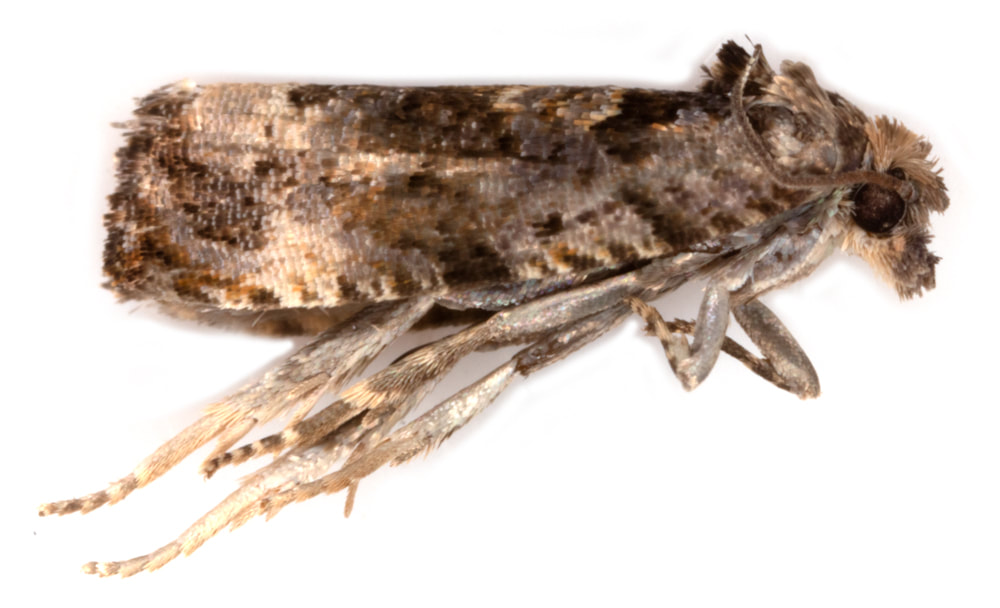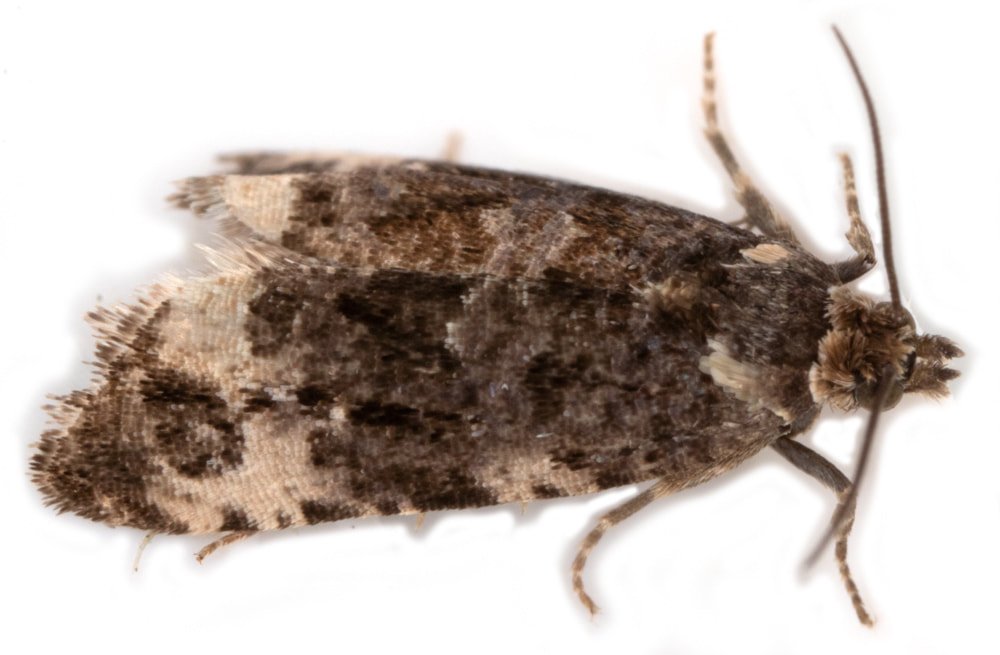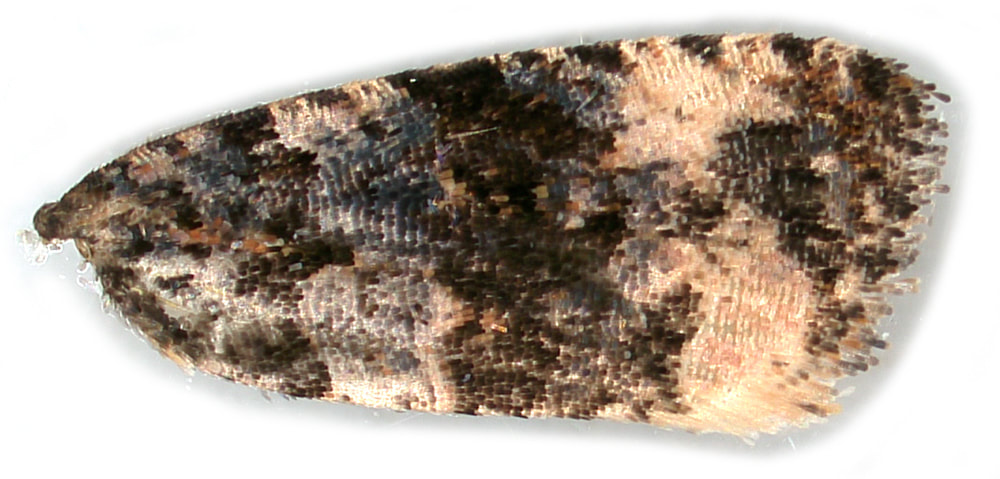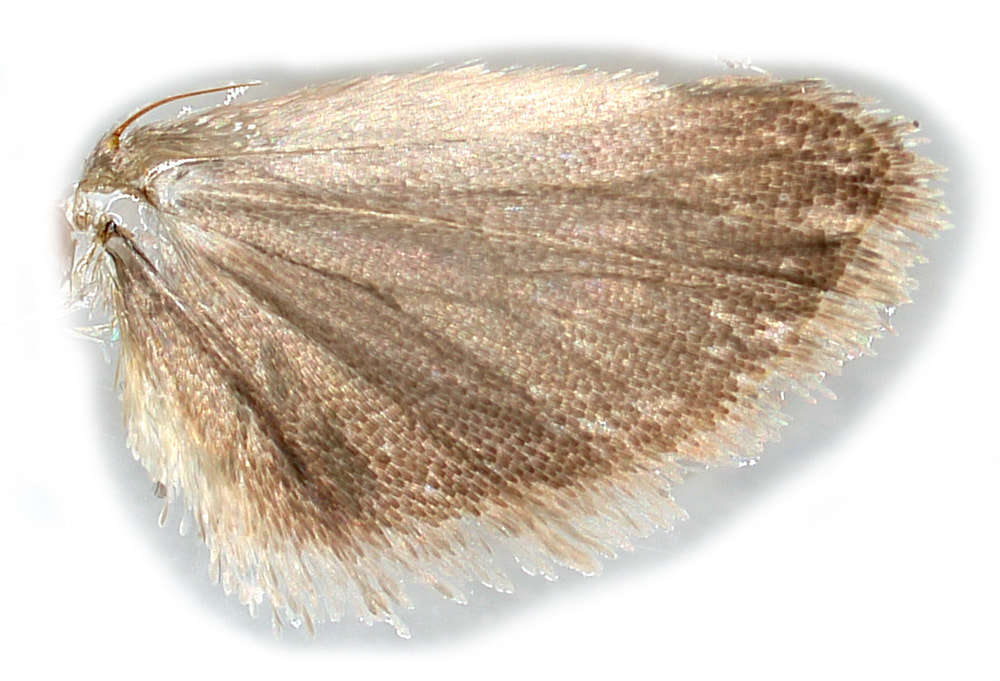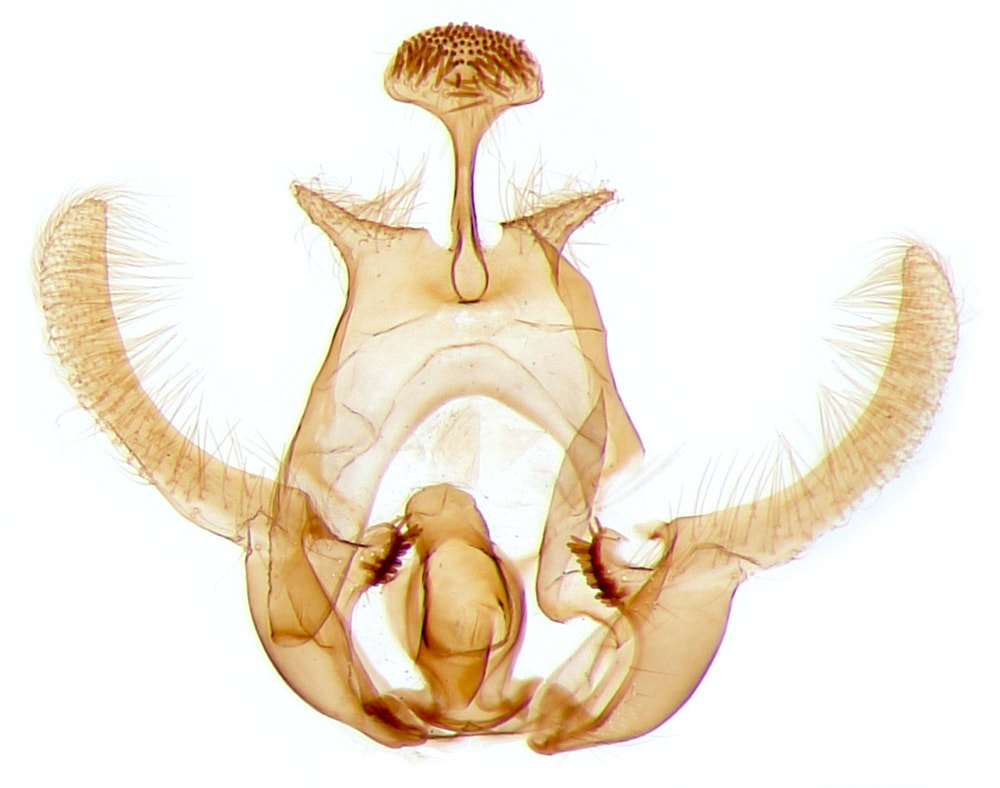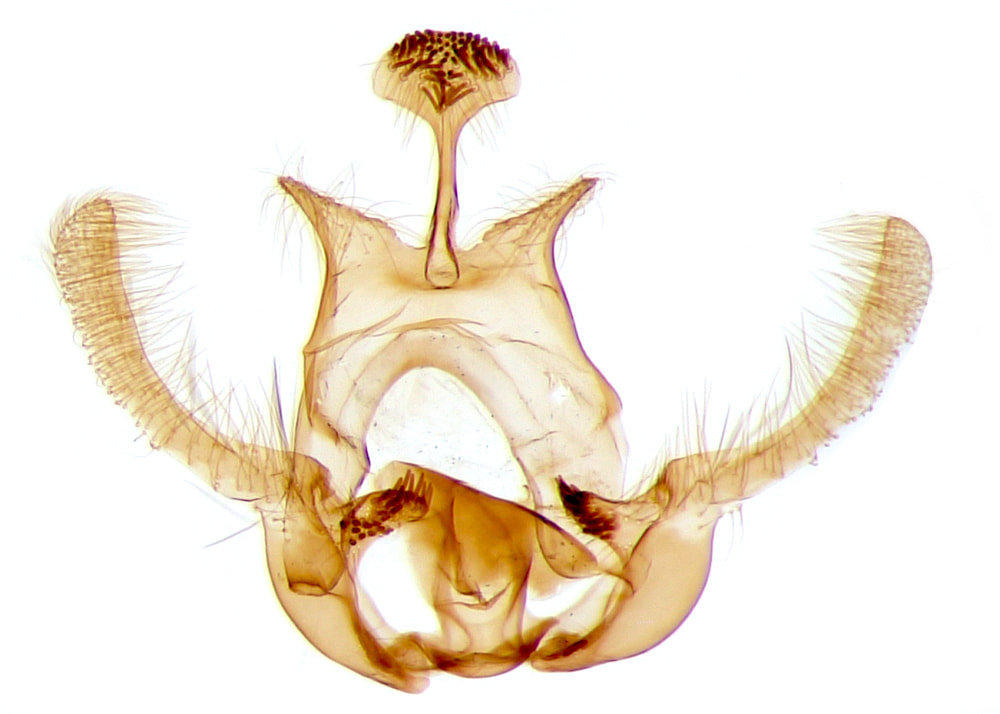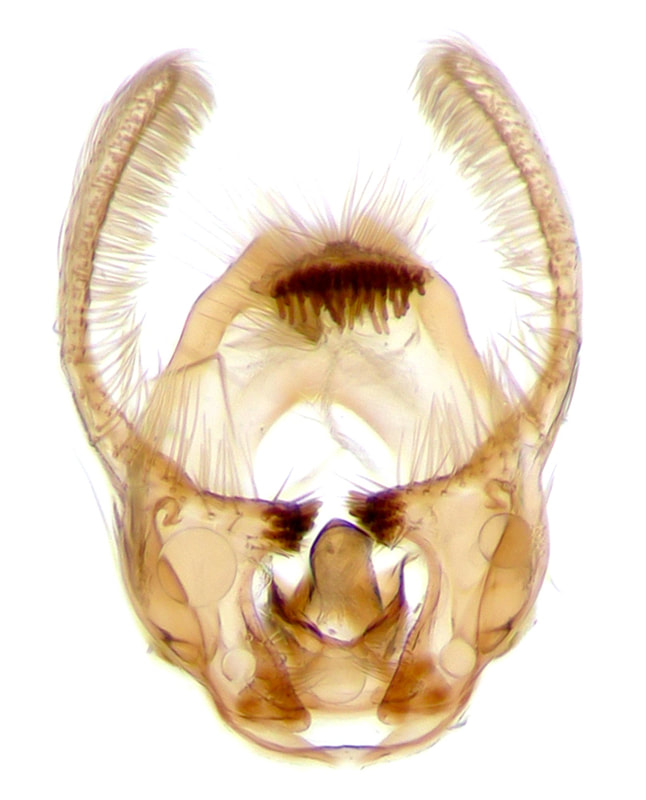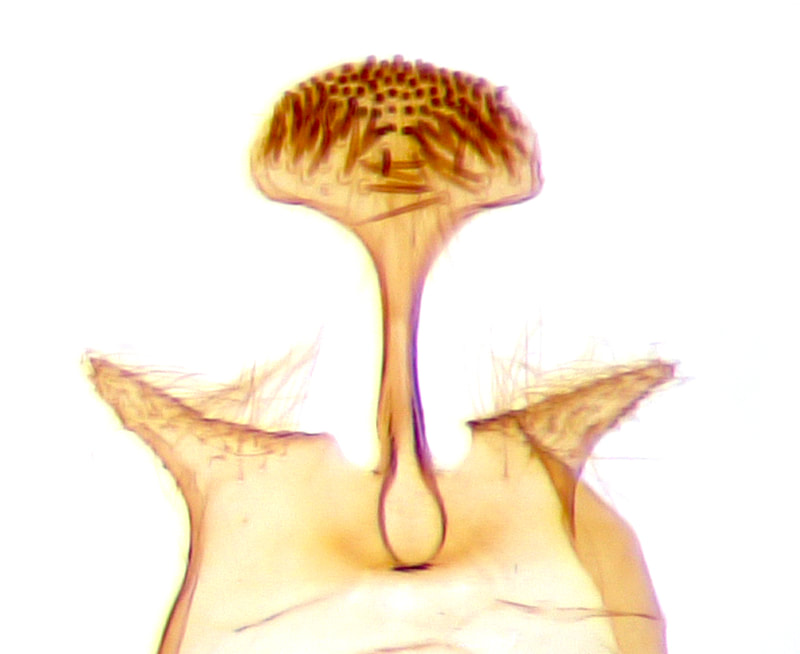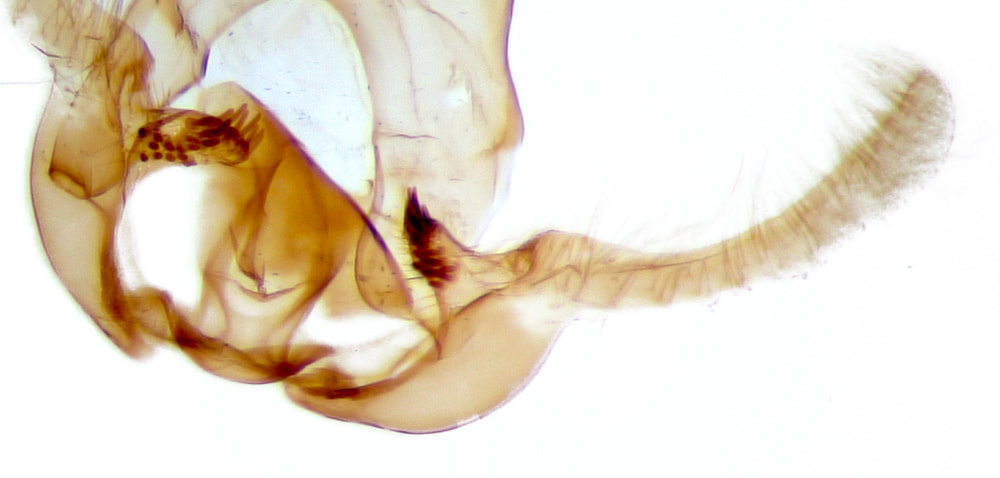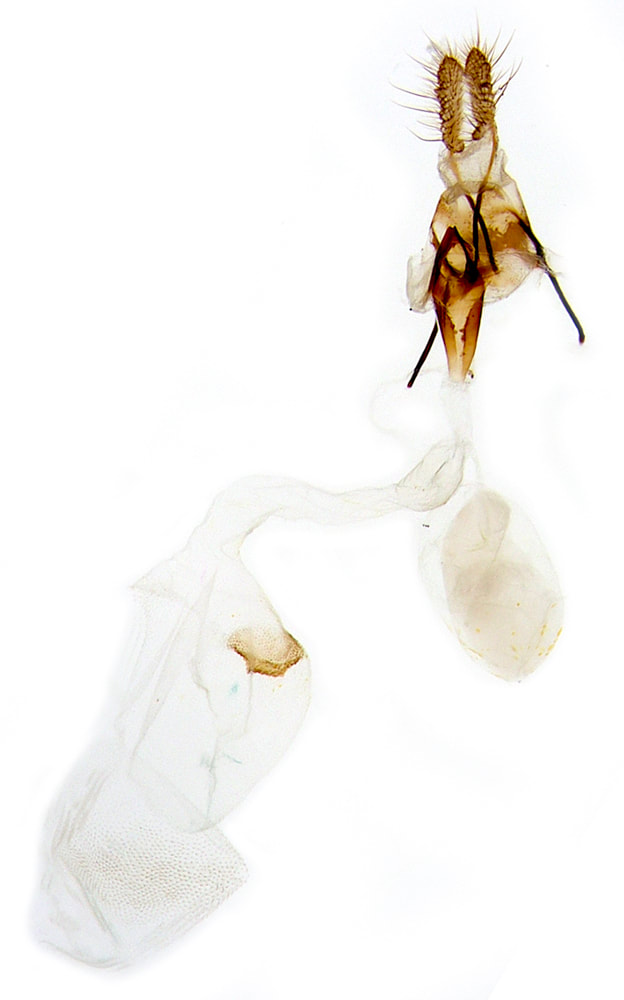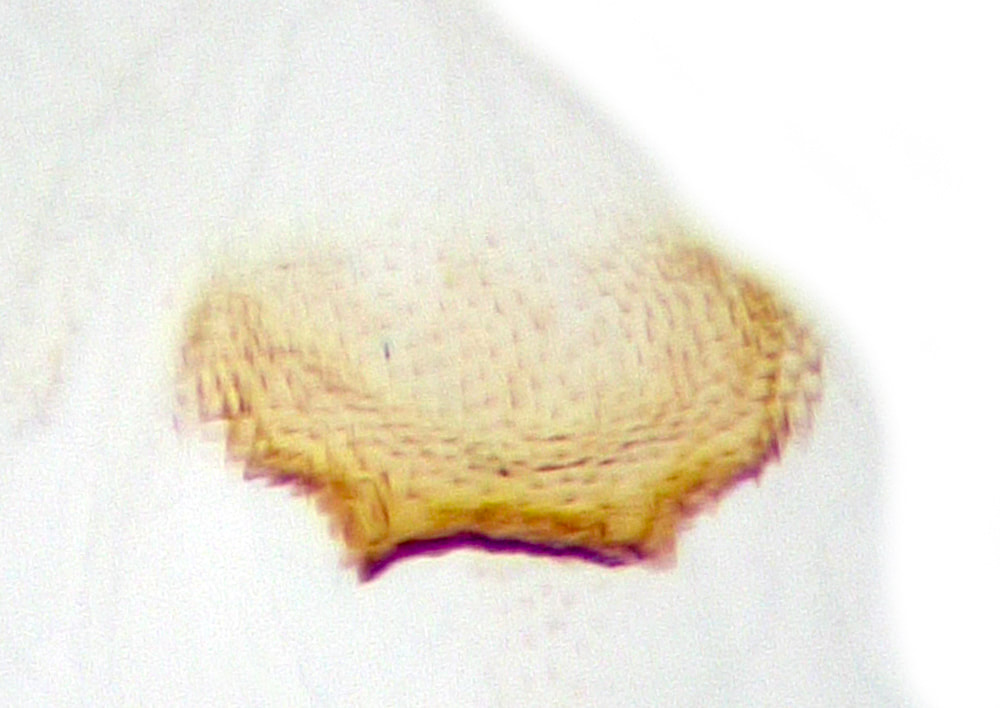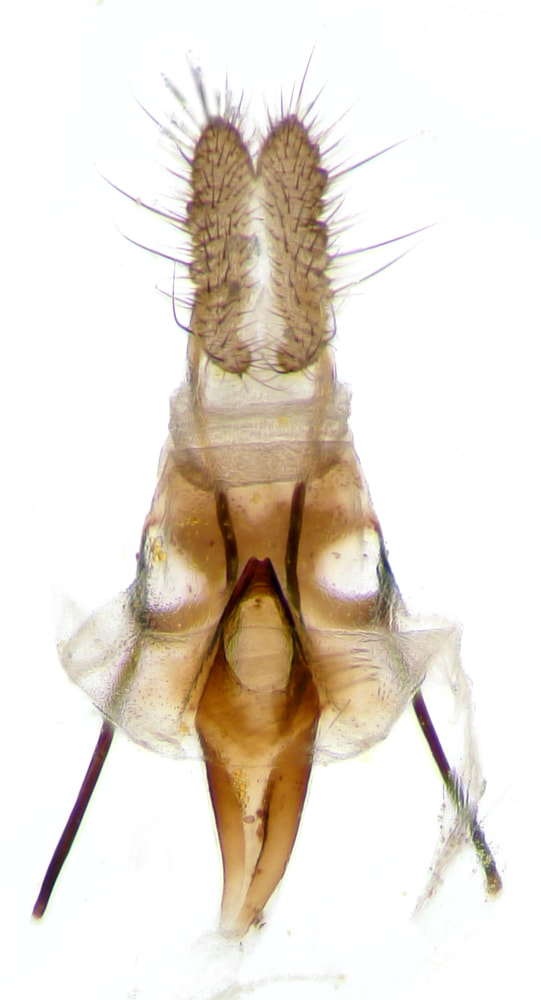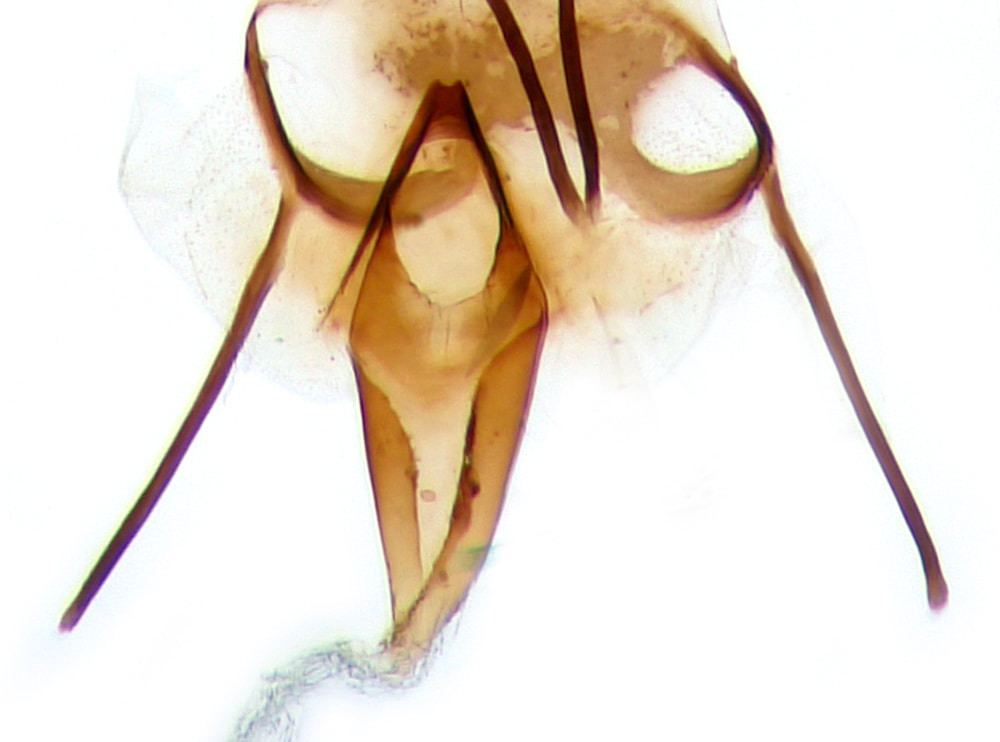49.187 Endothenia oblongana (Plantain Marble)
ws: 11-15mm (BTM), fw 5-7mm (Sterling & Parsons); Jun-Jul; common knapweed (Centaurea nigra) (MBGBI5.2) ribwort plantain (Plantago lancealata) (Sterling & Parsons); local in England & Wales
ID: Similar to E.genitianaeana which averages larger (fw 6-9mm) and E.marginana (fw 5-7mm). Males of E.marginana are distinct in having a white hindwing. Minor differences from its congeners in forewing pattern are mentioned in BTM and Clifton&Wheeler: the white subterminal fascia is relatively narrow and the terminal area relatively heavily suffused, resulting in less white than dark distal to the median fascia.
Male genitalia: In E.gentianaeana and E.oblongana the aedeagus is without cornuti, in E.marginana the aedeagus has (~9 short stout) cornuti. In all three species there is a spined ventral extension of the sacculus; in E.gentianaeana and E.oblongana this extension is at ~1/3 of the valva so that the valva beyond the extension is relatively long, in E.marginana this extension is close to 1/2 of the valva so that the valva beyond the extension appears relatively short. In E.oblongana the uncus is rounded; in E.gentianaeana the uncus is also rounded but its posterior margin is indented (two of the images labelled as E.gentianaeana at Moth Dissection show a rounded uncus without indentation); in E.marginana the uncus is flattened. MBGBI5.2 also illustrates a small difference between the 3 species in the exact form of the saccular extension, but I have yet to be convinced that this is useful in distinguishing E.gentianaeana from E.oblongana.
Female genitalia: My identification of §3 as E.oblongana sparked some debate as there has never been a confirmed record of E.oblongana for Scotland. I am grateful to Peter Hall and those mentioned below for engaging in the discussion. The conclusion of this debate is that the moth is probably E.marginana - but I leave it here along with something of the discussion, pending further information / evidence on the identification of females of these two species. My reasoning, as originally published was based on comparison with specimens I had previously identified as E.marginana, and was recorded as follows: "In E.gentianaeana and E.oblongana the posterior margin of the ostium is pointed; in E.marginana it is rounded. (As far as I have been able to establish): In E.gentianaeana the posterior margin of the ostium is pointed but not notched and the sclerotisation in the posterior part of the ductus bursae is separate from and weaker than the ostial sclerotisation. in E.oblongana the posterior margin of the ostium is pointed and notched at the point, and the sclerotisation in the posterior part of the ductus bursae is continuous with and about as strong as the ostial sclerotisation".
The following pieces of information have been gleaned from the discussion.
Nel: in his book (not sure which book this is) shows a notch at the posterior end of the ostium for E.marginana, but in personal correspondence (with Peter Hall) says that presence or absence of a notch is not useful in identification; that the identification is based on relative lengths of the anterior and posterior apophyses and that this specimen is E.oblongana
Larsson: in personal correspondence (with Peter Hall) has given the most detailed response which I summarise here:
1. In E.oblongana the ductus bursae has a large and relatively long expansion "just before the bursa" (which I interpret as "just posterior to the corpus bursae") and this is lacking in §3; this expansion is not so broad and closer to the colliculum in E.marginana.
2. The colliculum: "In E.oblongana it is narrowing while in E.marginana the sclerotized edge is more parallel - this means that in E.oblongana it is more difficult to see the inner edge". I have quoted this in full as I am not certain that my interpretation of it is what was intended, and I am not clear what the part after the hyphen means. I think he is saying that in E.oblongana the colliculum narrows anteriorly, while in E.marginana it is more parallel-sided - but that is inconsistent with his opinion that this character supports E.marginana for §3 or his statement that in §3 "the colliculum is shorter and less widening than normal" .
3. The signum in E.oblongana is bowler hat shaped; in E.marginana it is a little wider and more strongly sclerotised.
Peter Hall bases identification on the colliculum being "larger and wider" and "more robust" in E.marginana
Comparing images labelled as these two species at Lepiforum and Moth Dissection it seems to me that there is a larger and more obvious swelling of the ductus bursae in E.oblongana, that is occurs closer to the colliculum than to the corpus bursae (and gives origin to the ductus seminilis), and that this may be the only reliable feature for separating the two species. All the other features mentioned - apophysis length, shape of the ostium, colliculum and signum seem to be variable either in reality within each species or artefactually as a result of variation in the preparation and setting technique used.
Male genitalia: In E.gentianaeana and E.oblongana the aedeagus is without cornuti, in E.marginana the aedeagus has (~9 short stout) cornuti. In all three species there is a spined ventral extension of the sacculus; in E.gentianaeana and E.oblongana this extension is at ~1/3 of the valva so that the valva beyond the extension is relatively long, in E.marginana this extension is close to 1/2 of the valva so that the valva beyond the extension appears relatively short. In E.oblongana the uncus is rounded; in E.gentianaeana the uncus is also rounded but its posterior margin is indented (two of the images labelled as E.gentianaeana at Moth Dissection show a rounded uncus without indentation); in E.marginana the uncus is flattened. MBGBI5.2 also illustrates a small difference between the 3 species in the exact form of the saccular extension, but I have yet to be convinced that this is useful in distinguishing E.gentianaeana from E.oblongana.
Female genitalia: My identification of §3 as E.oblongana sparked some debate as there has never been a confirmed record of E.oblongana for Scotland. I am grateful to Peter Hall and those mentioned below for engaging in the discussion. The conclusion of this debate is that the moth is probably E.marginana - but I leave it here along with something of the discussion, pending further information / evidence on the identification of females of these two species. My reasoning, as originally published was based on comparison with specimens I had previously identified as E.marginana, and was recorded as follows: "In E.gentianaeana and E.oblongana the posterior margin of the ostium is pointed; in E.marginana it is rounded. (As far as I have been able to establish): In E.gentianaeana the posterior margin of the ostium is pointed but not notched and the sclerotisation in the posterior part of the ductus bursae is separate from and weaker than the ostial sclerotisation. in E.oblongana the posterior margin of the ostium is pointed and notched at the point, and the sclerotisation in the posterior part of the ductus bursae is continuous with and about as strong as the ostial sclerotisation".
The following pieces of information have been gleaned from the discussion.
Nel: in his book (not sure which book this is) shows a notch at the posterior end of the ostium for E.marginana, but in personal correspondence (with Peter Hall) says that presence or absence of a notch is not useful in identification; that the identification is based on relative lengths of the anterior and posterior apophyses and that this specimen is E.oblongana
Larsson: in personal correspondence (with Peter Hall) has given the most detailed response which I summarise here:
1. In E.oblongana the ductus bursae has a large and relatively long expansion "just before the bursa" (which I interpret as "just posterior to the corpus bursae") and this is lacking in §3; this expansion is not so broad and closer to the colliculum in E.marginana.
2. The colliculum: "In E.oblongana it is narrowing while in E.marginana the sclerotized edge is more parallel - this means that in E.oblongana it is more difficult to see the inner edge". I have quoted this in full as I am not certain that my interpretation of it is what was intended, and I am not clear what the part after the hyphen means. I think he is saying that in E.oblongana the colliculum narrows anteriorly, while in E.marginana it is more parallel-sided - but that is inconsistent with his opinion that this character supports E.marginana for §3 or his statement that in §3 "the colliculum is shorter and less widening than normal" .
3. The signum in E.oblongana is bowler hat shaped; in E.marginana it is a little wider and more strongly sclerotised.
Peter Hall bases identification on the colliculum being "larger and wider" and "more robust" in E.marginana
Comparing images labelled as these two species at Lepiforum and Moth Dissection it seems to me that there is a larger and more obvious swelling of the ductus bursae in E.oblongana, that is occurs closer to the colliculum than to the corpus bursae (and gives origin to the ductus seminilis), and that this may be the only reliable feature for separating the two species. All the other features mentioned - apophysis length, shape of the ostium, colliculum and signum seem to be variable either in reality within each species or artefactually as a result of variation in the preparation and setting technique used.
§1 St Mary's, Isles of Scilly; 02/08/2022; male; fw 5.9mm (specimen provided by Mick Scott)
§2 St Mary's, Isles of Scilly; 14/08/2022; male; fw 6.3mm (specimen provided by Mick Scott)
§3 Kishorn, Ross & Cromarty; 21/06/2022; female; fw 6.3mm; netted by day
All images © Chris Lewis
§2 St Mary's, Isles of Scilly; 14/08/2022; male; fw 6.3mm (specimen provided by Mick Scott)
§3 Kishorn, Ross & Cromarty; 21/06/2022; female; fw 6.3mm; netted by day
All images © Chris Lewis
Page published 13/09/2022 (§1&2) | §3 added 11/12/2022
